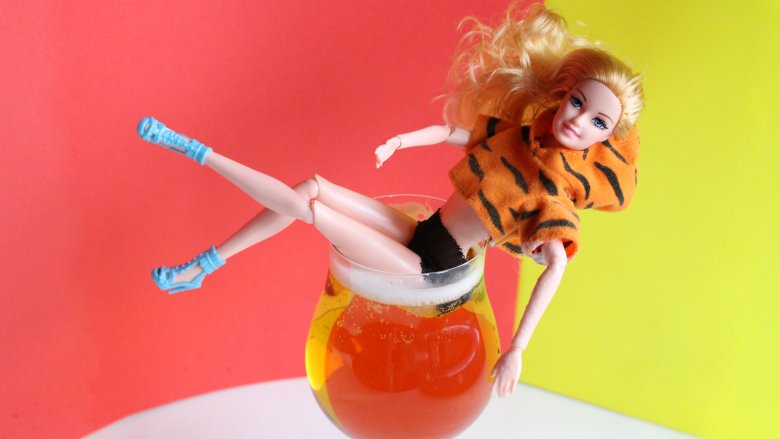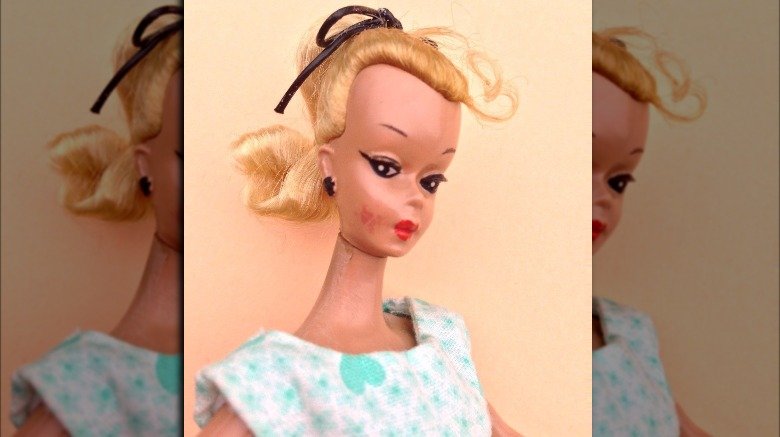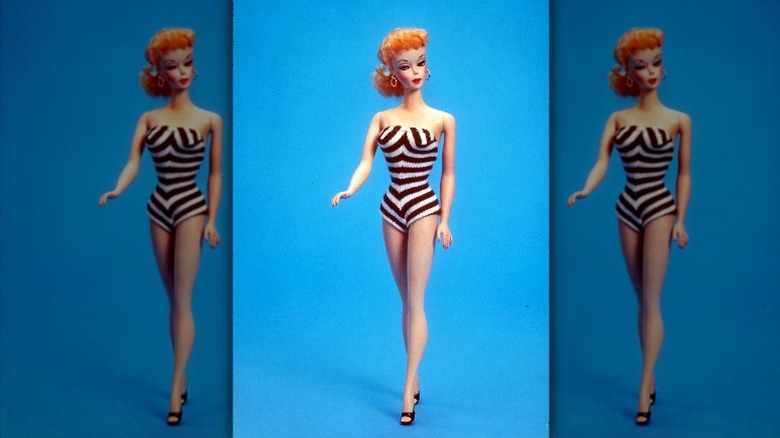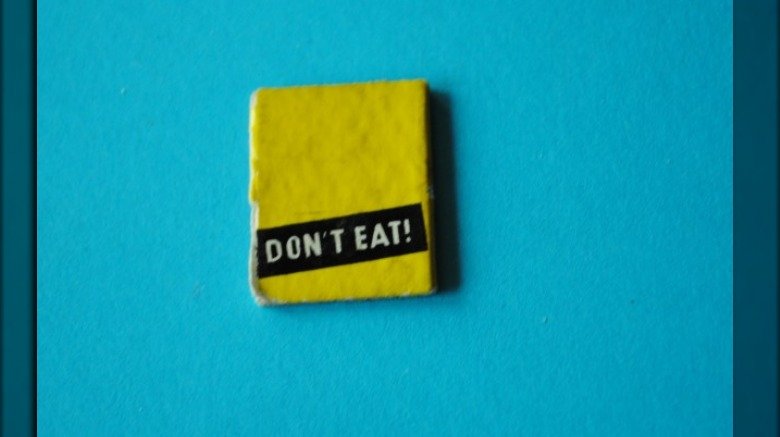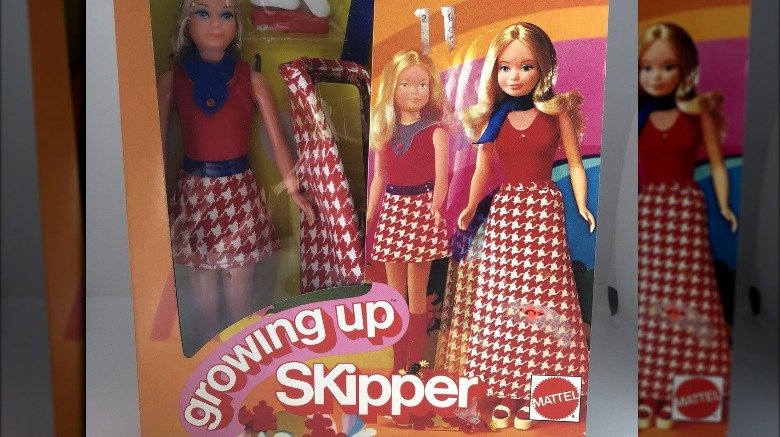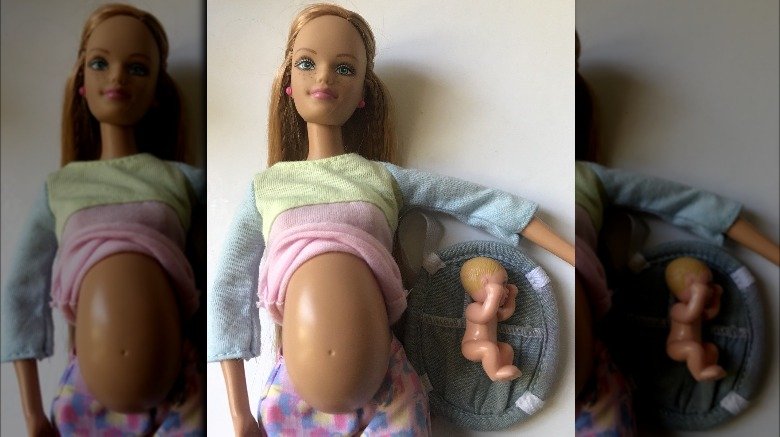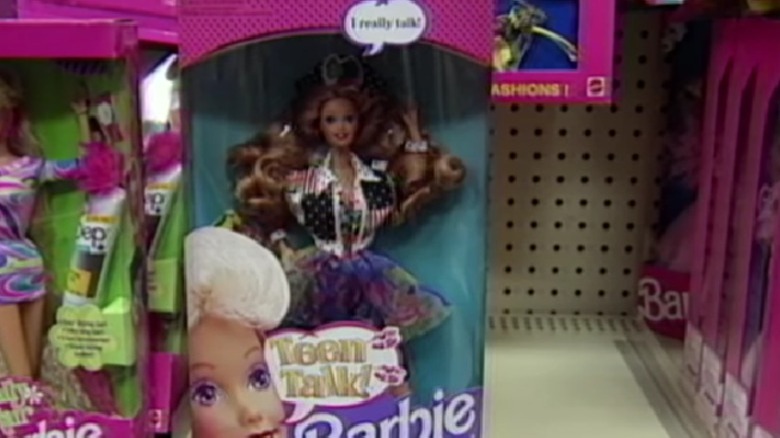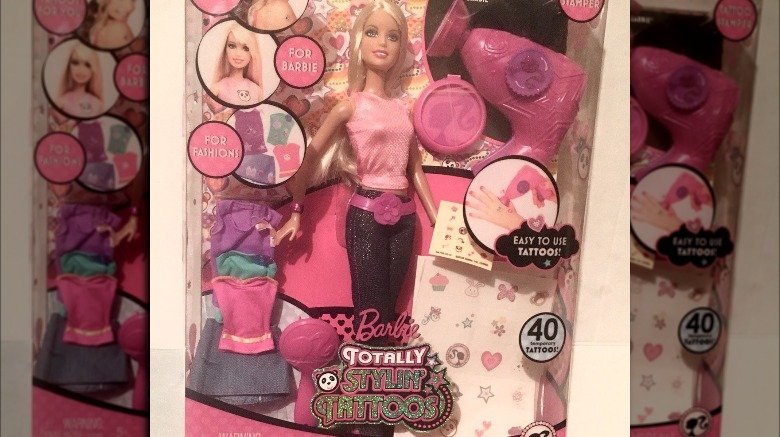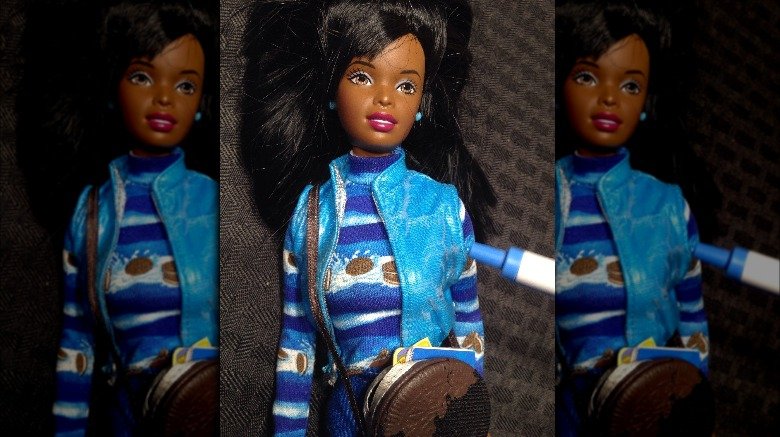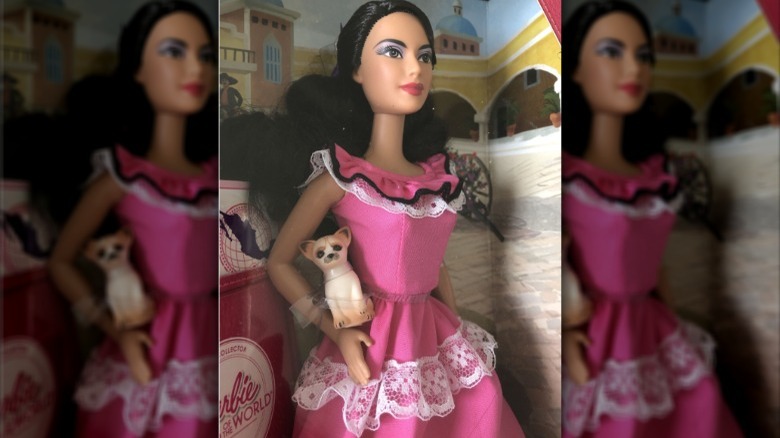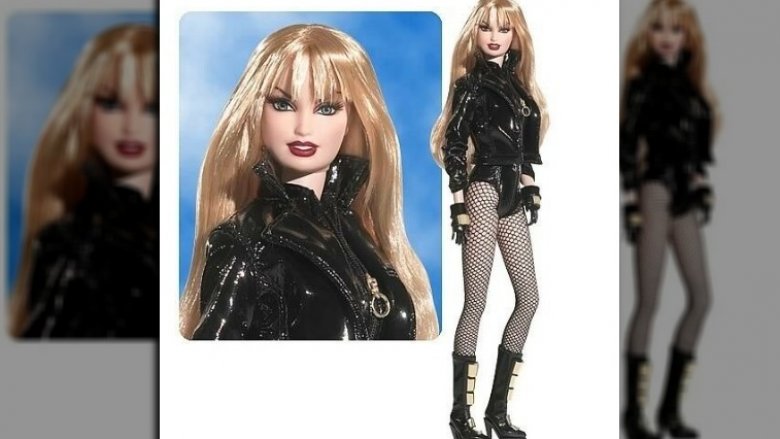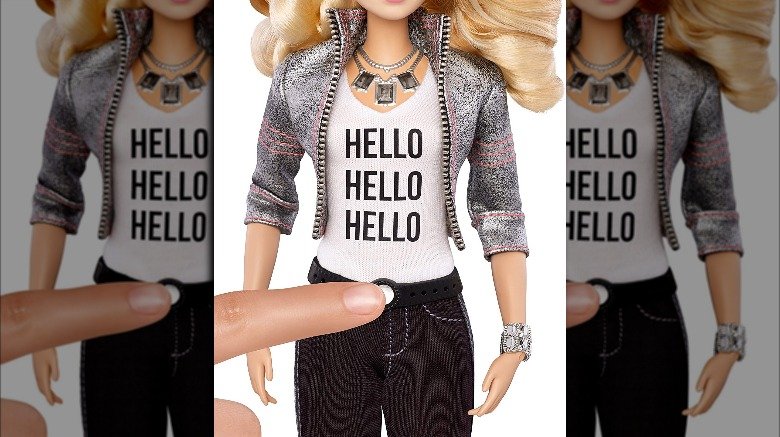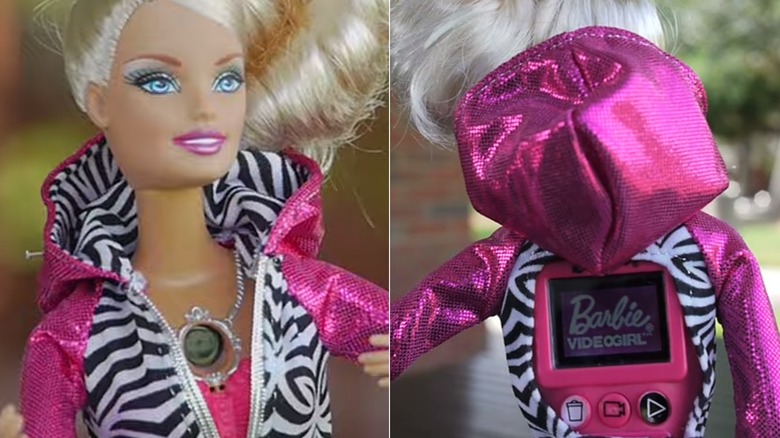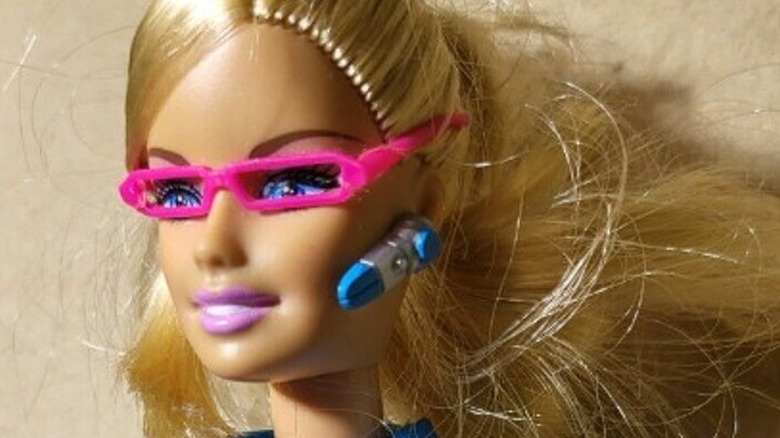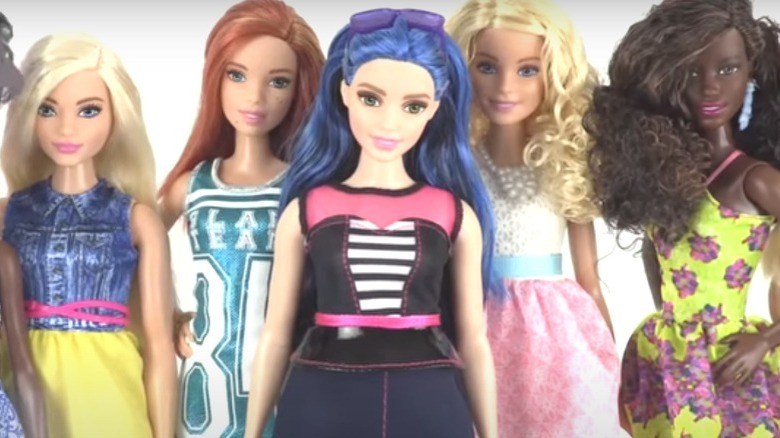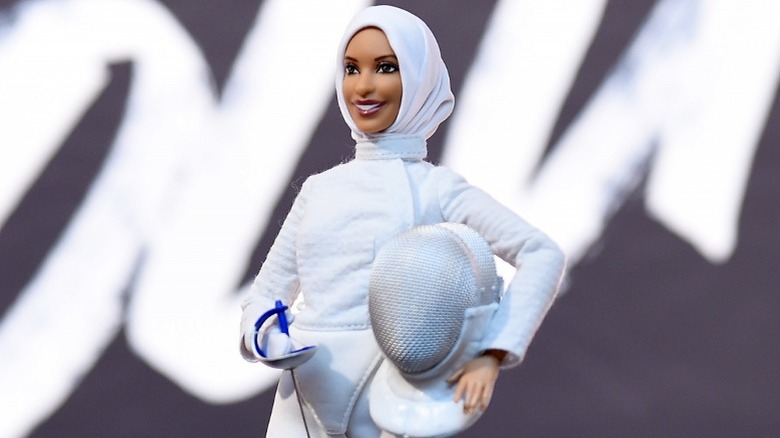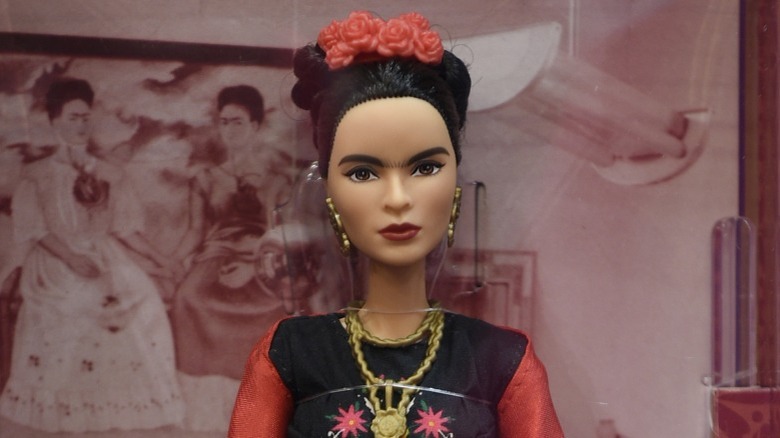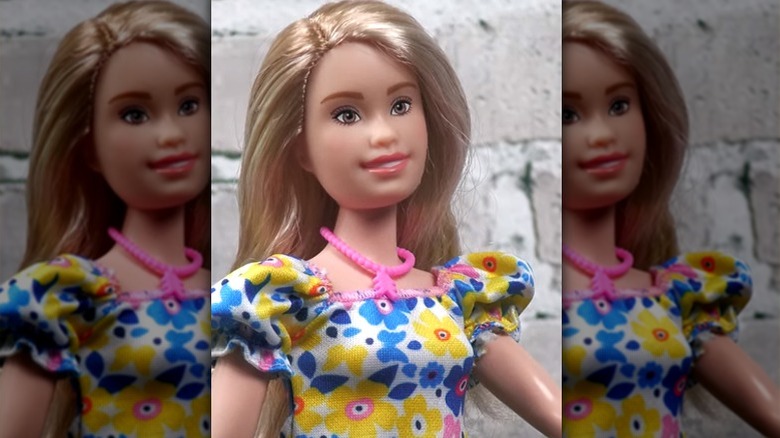Barbie Dolls That Caused A Ton Of Controversy
Americans have a complex relationship with toys. There are toys we hate, like Furbies (shudder) and TeleTubbies (double shudder), and there are toys we love, like Lego and Crayola, and then there are toys that will destroy the universe and all who inhabit it. Like Barbie.
Yes, perhaps no other toy has been quite so controversial as the blonde bombshell with the impossibly tiny waist who has somehow managed to hold every conceivable job ever invented by humans — with the possible exception of "trash collector" because while Trash Collector Barbie would have been especially popular with the grown-ups there really aren't very many little girls who would know where the hell they were supposed to take that particular imaginary storyline.
Barbie is so controversial that some parents think little girls who play with them will become adults with poor career ambitions who are plagued by unrealistic ideas about what their bodies should look like. And that's not just parental hysteria, either, that's based on real, actual research. But that's not the worst of it — throughout Barbie's very long life, she's had to endure a ton of other controversies, starting with the day she was born.
Barbie's predecessor was a high-end call girl
If you always thought Barbie was kind of just wrong, there's a good reason. The doll Barbie was based on first appeared in Germany in 1952, and it was not meant to be a kids' toy. Nope. According to Time, Barbie was based on a doll called "Bild Lilli," which was the plastic version of a "saucy high-end call girl" who appeared in adult comic strips. Lilli was sold in adult-themed toy stores, right next to things we can't actually mention here because this is a (relatively) family friendly website. She was also sold in tobacco shops and bars, which — despite Barbie's reputation as a girl who really can't seem to figure out what she's going to do with her life — do not seem like the sorts of places she'd spend her time.
The Lilli doll, as you've already guessed, was not meant for kids but for adult men, who would get them as bachelor party gifts and then do god-knows-what with them, like strap them to the handlebars of their motorcycles or put them on their office desks where they would forever make female coworkers uncomfortable.
But it wasn't just men who dug these things. They were popular with kids, too, and when Mattel co-founder Ruth Handler discovered Bild Lilli while on vacation in Switzerland, she saw its potential as a kids' toy and brought a few of them home to use as the Barbie doll's prototype.
The Original Barbie
The very first actual Barbie was introduced at the American International Toy Fair in 1959. And because Mattel was evidently not aware of just how innocent the adult population of America actually was in 1959, the Post-Bulletin says they gave her the tagline "A shapely teenage fashion model," which is still seriously discomfort-inducing in modern America and must have been shocking in the late '50s.
At first, it seemed like the only person who really liked Barbie was her creator, Ruth Handler. There were designers at Mattel who openly expressed doubts that parents would want to buy such a thing, and even Mattel's sales people were skeptical. As it turned out, they were right — wholesalers didn't like Barbie, either. Most importantly, though, mothers didn't like Barbie, and they were the ones in charge of the cash. Handler knew this was going to be a problem, so she hired a "Freudian-influenced" marketing guy to help her figure out how to sell the doll. He interviewed 191 girls who loved Barbie and 45 moms who hated her, and the conclusion he came to was ... wait for it ... Barbie should have bigger boobs. Oh and moms should be told that Barbie will help their daughters learn how to accessorize. Because let's face it, there's really no loftier goal than raising a child who knows how to match her heels to her scarf.
Slumber Party Barbie
So once parents started to get used to the idea of their little girls playing with dolls shaped like grown adult women, Mattel decided to mix it up by releasing a Barbie doll that not only featured very unrealistic female proportions but also seemed to be advising girls how they, too, could look freakishly weird in a bikini. According to Huffington Post, the 1965 release "Slumber Party Barbie" came with a robe, pink silk pajamas, and some other stuff that Barbie would clearly need while hanging out with the gals, like hair care supplies, pink open-toed heels (wait, what?), a bathroom scale forever locked at 110 pounds, and a book titled "How to Lose Weight." Because A) everyone knows girls at slumber parties never eat popcorn or pizza or any other kind of junk food because the sole purpose of a slumber party is to fast and share diet tips, and B) Barbie totally needs to lose weight. Oh and for some reason girls at slumber parties wear high heels with their silk pajamas.
Anyway that's really not the worst of it — the worst of it is that the book's sole piece of advice, printed on its back cover, was this: "Don't eat!" So that was evidently supposed to be super funny because hahahaha anorexia is hilarious.
Growing Up Skipper
In 1964, Mattel decided to give Barbie a kid sister, who they named "Skipper" because everyone knows having a kid sister is exactly like having a puppy. Then in 1974 they decided that Skipper could not remain a child forever and must finally join Barbie (who was inexplicably still exactly the same age) as an unrealistically proportioned teenager. (Or adult? We're still not sure which one of those Barbie is supposed to be.)
But for some reason, Mattel didn't just release a teenage version of Skipper, because that would be bypassing the magical joy of puberty, which every child hopes to experience over and over again through their playthings. According to Messy Nessy, this particular version of Skipper looked like a child, but when you rotated her arm she grew taller and got boobs. Fortunately, Mattel did not give Growing Up Skipper acne and hormonal drama.
Parents mostly hated this doll, as you can imagine, and Mattel wisely decided to stop selling it in 1977. But wait, it's not like they filed that one away as "lesson learned" or anything. As recently as 2007, parents who really wanted their kids to experience the joys of plastic puberty could purchase the same basic doll (called "Growing Up Glam"), only this particular version featured a miniskirt, crop top, half-lidded eyes, and duck lips, which looked exactly as disturbing as it sounds.
Happy Family Midge
So at this point you're probably wishing you could travel through time to the 1960s and '70s and slap everyone who worked at Mattel, but you'll also have to stop by the early 2000s because it didn't really get much better with time.
In 1963 Mattel responded to accusations that Barbie was too sexy by releasing her much less-sexy "friend," Midge. Midge was more child-like than her counterpart, which is why it was so very bizarre that Mattel decided in 2002 that "Knocked Up Midge" was a totally rational idea. Okay so they didn't literally call her "Knocked-up Midge," but still, they were basically telling their young customers that teen pregnancy was a-okay.
According to Boing Boing, this particular freak show of a doll featured a magnetic belly that you could pop off in a horrific facsimile of the world's most gone-awry C-section. Inside there was an articulated fetus poised for childbirth. Critics accused Mattel of promoting teen pregnancy and teen sex, so Mattel tried to fix their misstep by adding a wedding ring to later versions of Pregnant Midge because for some reason they did not get the hint that the whole thing was really just not a good idea. Apparently, teen marriage somehow makes it all better.
Dolls were pulled of shelves, and Mattel re-released Midge, sans baby bump, with a nod to her husband Alan and toddler son Ryan.
Teen Talk Barbie
By the 1990s, Mattel still for some reason had not figured out that parents didn't especially love to buy toys that idealize women as empty-headed, anorexic sex objects. Teen Talk Barbie — obviously designed by a bunch of old guys brainstorming the things they imagined teenage girls might talk about when no one was listening — came out in 1992 and immediately pissed off a bunch of people just like so many other Barbies before her. She was a verbal Barbie, and she mostly sat around talking about things like weddings, clothes ("Will we ever have enough clothes??"), and shopping, which everyone knows are the only things teenage girls are interested in.
Anyway, according to The New York Times, the one phrase that really got everyone's hackles up was this one: "Math class is tough!" Critics (rightfully) complained that the phrase perpetuated the stereotype that girls can't be good at math. But this story does have a happy ending because a group called the Barbie Liberation Organization bought a bunch of Teen Talk Barbies and switched out their voice boxes for GI Joe voice boxes so GI Joe would say "Will we ever have enough clothes??" And Barbie would say "Vengeance is mine!" and then the group put them back on the shelves just in time for Christmas. So that's hilarious except for the part where a bunch of little kids were crying on Christmas morning, but hey, it was all in the name of Barbie's liberation, right?
Mattel did acknowledge its mistake, omitting the offending phrase from the computer chip (but they did not recall the original Barbies).
Totally Stylin' Tattoo Barbie
Throughout the ages, parents have been all, "Hell no, you're not getting a tattoo." So why Mattel thought it was a good idea to release tattooed Barbie dolls is beyond comprehension. But they did, and now you're thinking, "well, at least they were understated, tasteful tattoos, right?" But surprise! They weren't. Nope. When Mattel released their tattooed Barbie they decided to go straight for the tramp stamp.
Totally Stylin' Tattoos Barbie was a 2009 release, thus proving that Mattel never, ever learns from its mistakes. The doll came with tattoo stickers so girls could cover Barbie in ink however creatively they wanted to and a tramp stamp with Ken's name on it, which is problematic for a couple reasons. First, it's a tramp stamp, and second, everyone knows tattooing yourself with the name of your one true love is a terrible idea because you can't wash it off after you realize that he was not, in fact, your one true love. So just not a great idea all around.
Oreo Barbie
We like to think that this one was pure stupidity rather than overt racism, but here's the story. In 1997, Mattel and Nabisco got together for drinks or something because there's really no other way to explain this, and when they were drunk they said to each other, "You know what the world needs? A Barbie doll that dresses like an Oreo." So then they sobered up but evidently still thought it was a good idea, and Oreo Barbie was born.
According to My American Melting Pot, the first version did surprisingly well and the second version in 2001, not so much, because one of the dolls was African-American. And while pretty much everyone on Planet Earth understands why that was a terrible idea, Mattel and Nabisco were both totally clueless until the backlash began.
Just in case you are actually one of the few remaining humans who doesn't know why it's not okay to call a black girl an "Oreo," it's a derogatory term one might use to accuse a Black person of being white on the inside, not unlike the iconic cookie itself.
So after this all went down, Mattel and Nabisco were sufficiently shamed and they recalled the black Oreo Barbie dolls and never released a stupid, ignorant doll again, except of course they did because Mattel never learns from their mistakes. So we won't even mention Ritz Cracker Barbie, who was totally real and was white and is now officially just known as "Cracker Barbie."
Dolls of the World collection
So it wasn't enough for Barbie to just stereotype teenage girls, they were not at all opposed to stereotyping everyone else, too. In the early '80s, Mattel launched the Dolls of the World series, featuring Barbies representing different world cultures. While this might seem like a step towards inclusivity, they weren't without problems. One of the first of the series, "Oriental Barbie," wasn't given a specific country like the others, and her name completely ignored Asian Americans' pushback and what they considered a derogatory term.
Fast forward to 2012, which is ridiculously recent for how stupid this is, Mattel decided to reintroduce Mexican Barbie (there had been previous versions), replete with a dress that looks like something they might force waitresses to wear at a Mexican restaurant in Cincinnati, a chihuahua because all Mexican girls have chihuahuas, and a passport, as if to suggest she's not undocumented.
To be fair, pretty much every doll in this series was a ridiculous stereotype, from the French Barbie who wore a beret and literally carried a baguette around in a basket to Russian Barbie with her giant fur hat and hand warmer. So at least Mattel was an equal opportunity stereotyper.
Black Canary Barbie
To their credit, most of Mattel's Barbie doll releases stopped just short of being trashy. Mostly. And it's worth noting that other doll lines did veer off in a trashy sort of direction, so it's not like we can say that this next doll was an anomaly or anything. But yeah, Mattel did release a couple of really inappropriate Barbies, most notably the Black Canary Barbie, who was modeled after a DC superhero that pretty much no Barbie-buying child had ever actually heard of. Now in the DC comics, the character does wear some not-very-practical crime-fighting gear, like high-heeled boots and fishnet stockings, which really, dear, how do you expect those to not get snagged on the supervillain's steampunk doomsday device?
According to Newsarama, Mattel's Black Canary Barbie was totally faithful to the DC character, but that didn't excuse it in the eyes of critics (mostly just critical religious groups). At a price point of $40, though, it's doubtful Mattel was even trying to market the doll to children, but that didn't stop Black Canary Barbie from earning the moniker "S&M Barbie." So behold, Mattel had finally crossed a line. Based on everything we've heard so far it's a really big, really fat, shifty line, but they did finally manage to cross it.
Hello Barbie
What could be creepier than a plastic doll that grows breasts? How about this one: a plastic doll that you talk to and it talks back. You're probably thinking, "Whatever, dolls have been saying 'Mama' for decades," but this is not the same thing. According to Newsweek, Hello Barbie is a doll kids can talk to and that actually listens but in the creepiest way possible. Kids can tell this Barbie their troubles, and Barbie will answer with one of 8,000 programmed responses.
So how exactly does Barbie know what to say? Well, she makes a recording of the child's voice and uploads it to the servers at a company called ToyTalk, and then the servers translate it into text and look for responses that match whatever keywords it found. And because that's not creepy enough, the servers also save all that data so Barbie will come to know her owner in a way that only her owner's mom and freaking Chucky from that 1980s horror movie can. Oh and there's also that bit about how Mattel and ToyTalk get to use all that data in other ways if they feel like it. "They really shouldn't call it Hello Barbie," said a spokesperson from Campaign for a Commercial-Free Childhood. "They should call it Surveillance Barbie."
Video Girl Barbie
With her hip jean capris and hot pink heeled boots, 2010's Video Girl Barbie seemed just like any other innocent millennial girl out for fun. But Mattel, appealing to young girls interested in filmmaking, had equipped her with a dangerous weapon. Embedded in her cute little necklace was a tiny lens that relayed video to a small but respectable LCD screen embedded in her back. To power her espionage set-up, sneaky cyborg Barbie hid a triple A battery in each leg. She could record up to 25 minutes of footage, which could then be downloaded to a computer for editing via a small cable connected above her derriere. Ah, the magic of technology.
While she might seem tame by modern standards, Video Girl Barbie launched at a time when things like influencers, smartphones, and YouTube were still in their infancy. A tiny spy cam was still pretty scary to a lot of people — and Mattel's creepy marketing statements, noted by Ars Technica, like "unsuspecting subjects won't know that Barbie is watching their every move" didn't help.
Ultimately, it was the FBI that stirred up controversy when they issued a "Cyber Crime Alert" warning law enforcement agencies that the dolls could be used for child pornography and should be considered evidence if found at crime scenes. Though allegedly nothing had happened to precipitate the horrifying warning, it inevitably leaked to the masses, and soon many were boycotting the doll just over the idea of it all. Way to kill a girl's fun.
Computer Engineer Barbie
In 2010, Mattel released a tech-savvy Barbie who worked with computers, which made perfect sense considering the era's rapid expansion of technological fields. But, once again, the company got in trouble over its tasteless and potentially harmful accessories. In addition to a binary-code emblazoned shirt, heart-shaped flash drive, hip spectacles, Bluetooth headset, and, of course, a pink laptop, the doll's release came alongside a problematic picture book titled "Barbie: I Can Be a Computer Engineer."
In the book, a bumbling Barbie accidentally installs a virus onto her sister Skipper's computer, professes to only be a designer who always relies on the help of her two male classmates — Steven and Brian — for complicated things like coding, and is generally portrayed as incompetent in her field despite her upper-level title, which implies some sort of advanced degree in computer technology. The book's stereotype-ridden plot was so atrocious and blatantly sexist that it went immediately viral upon its rediscovery in 2014.
People positively tore the story apart through Twitter jokes and scathing blogs, which argued that it sent a terrible message to young girls. Many also posted more appropriate rewrites of the book online, in which Barbie works as a computer programmer more befitting of her high-level title. In response to the intense backlash, Mattel issued a sheepish apology and pulled the accompanying book from Amazon. Though Barbie still works in tech, it's assumed that she's finally gotten that well-deserved promotion. Oh, and Steven and Brian now work for her.
Curvy Barbie
Technically, the idea of a plus-sized Barbie was controversial before she even got made. A rendered image of a voluptuous triple-chinned version of Barbie that circulated on social media in 2013 became something of a scandal online, with many people claiming that such a doll would advocate for all-new unhealthy habits rather than promote the acceptance of bigger body types. The backlash was so great that no truly plus-sized Barbie ever saw the light of day — though Mattel was undoubtedly paying attention to the heated debates.
Instead, the company — humbled by years of plummeting sales and seeking ways to address parents' repeated demands for some semblance of anatomical realism and diversity in the Barbie canon — opted for its 2016 Fashionistas series, which celebrated at least a few other body types besides just "disturbingly thin." Barbie now came in three options: "petite," "tall," and "curvy." Curvy dolls — basically as plus-sized as Barbie ever gets — are still pretty thin by most peoples' standards, which caused its own controversy.
Still, they do feature slightly fuller hips, thighs, calves, stomachs, and arms, creating the impression of a somewhat more anatomically accurate adult woman's body. Unsettlingly, a 2019 study published in Body Image found that many young girls still refer to them as fat, which kind of proves that the whole unrealistic female body image problem goes a little deeper than just Barbie. Comically, the biggest complaint about curvy Barbies is that the clothes are no longer fully interchangeable between all dolls. Priorities.
Ibtihaj Muhammad Barbie
In 2017, Mattel created a Barbie to commemorate American Olympic fencer Ibtihaj Muhammad as part of their Shero — as in "she" plus "hero" – line. Fashioned in Muhammad's likeness, the doll came complete with a saber, protective mask, and headscarf called a hijab. While you'd think that releasing a Black Barbie wearing traditional Muslim garb would be considered inclusive and progressive, many took umbrage with the release — and for a variety of reasons.
Some, like Self writer Sarah Hagi, claimed that it was problematic that such a Barbie wasn't released until a Muslim woman did something exceptional, like win an Olympic medal, which furthered the notion that Western cultures expect Muslims to continuously prove their worth to be seen as equals (versus, you know, the tons of white blonde American Barbies portrayed doing mundane everyday things like babysitting and suntanning).
Others felt that it was a hollow and purely economically motivated gesture. As Islam and gender scholar Shenila Khoja-Moolji wrote in Al Jazeera, it could be seen as a way for Mattel to commodify Islam by treating the religion as yet another target market to exploit, profiting off Muslims in a form of "racial capitalism." She added that Mattel's Barbie did little to improve American Islamophobia, which was especially rampant at the time of its release. Many feminists were also upset about the doll's hijab, which they argued is a symbol of misogyny that is not donned or supported by all Muslim women.
Frida Kahlo Barbie
Not every woman is fit to be Barbified, and many would argue that Frida Kahlo is one such woman. Mattel claimed that it got the rights to create a Barbie of the late Mexican artist from her niece, Isolda Pinedo Kahlo, a decade before the doll's launch in its 2018 Inspiring Women series. But some of Frida's more distant family members, including her great-niece Mara Romeo, claimed that the toy company did not have permission to use Frida's likeness and sued Mattel – not for money but to demand a redesign.
Romeo told AFP News (via the BBC) that she was displeased with how Frida was portrayed in doll form, citing her too-light eyes and complexion, lack of joined eyebrows, thin frame, and inaccurate style of dress. In general, many felt that making Frida into an American doll famous for her unrealistic body and penchant for consumerism was, well, not very on brand considering Frida was a lifelong communist who regularly bucked gender roles at a time when that wasn't exactly widely accepted.
Actress Salma Hayek – who portrayed the legendary artist in the 2002 film "Frida" — was also outspoken about Barbie Frida, expressing disappointment over how Mattel had erased the artist's most defining features while presenting the doll as an inspiration for young girls. "#FridaKahlo never tried to be or look like anyone else. She celebrated her uniqueness," Hayek wrote on Instagram (via Vogue). "How could they turn her into a Barbie." An injunction was granted, and Mattel stopped producing Frida dolls — at least in Mexico.
Down Syndrome Barbie
Barbie's maker, Mattel, has been making an effort to be more inclusive in recent years, though, let's be honest, they have a huge stigma to dismantle before people will stop seeing Barbie as the blonde, unnaturally thin, unattainable beauty ideal that she's been for so many decades. Still, the company is trying. Mattel has been slowly reinventing the Barbie institution through its Fashionistas line, which strives to provide children with a more realistic range of body types, skin tones, and impairments. The collection already features heavier-set Barbies — something many thought would never happen — and dolls with hearing aids, prosthetic legs, and the skin condition vitiligo.
Then, in 2023, Mattel added its first Barbie with Down syndrome to the line. The company partnered with the National Down Syndrome Society to create the doll, which features the elongated torso, short stature, and slightly slanted eyes associated with Down syndrome. She also wears a necklace with three chevrons — a representation of the three chromosomes that cause the condition — pink leg braces, and a blue and yellow dress adorned with butterflies, all common symbols of Down syndrome awareness.
While plenty of people were pleased with the doll, several voiced concerns that it did not accurately portray a person with Down syndrome and instead completely stripped away the identity. One Twitter user, @JaydenJPeel (via Sportskeeda), even tweeted: "This is making fun of people with Down syndrome." Many have called for a more true-to-life redesign based on real models.
